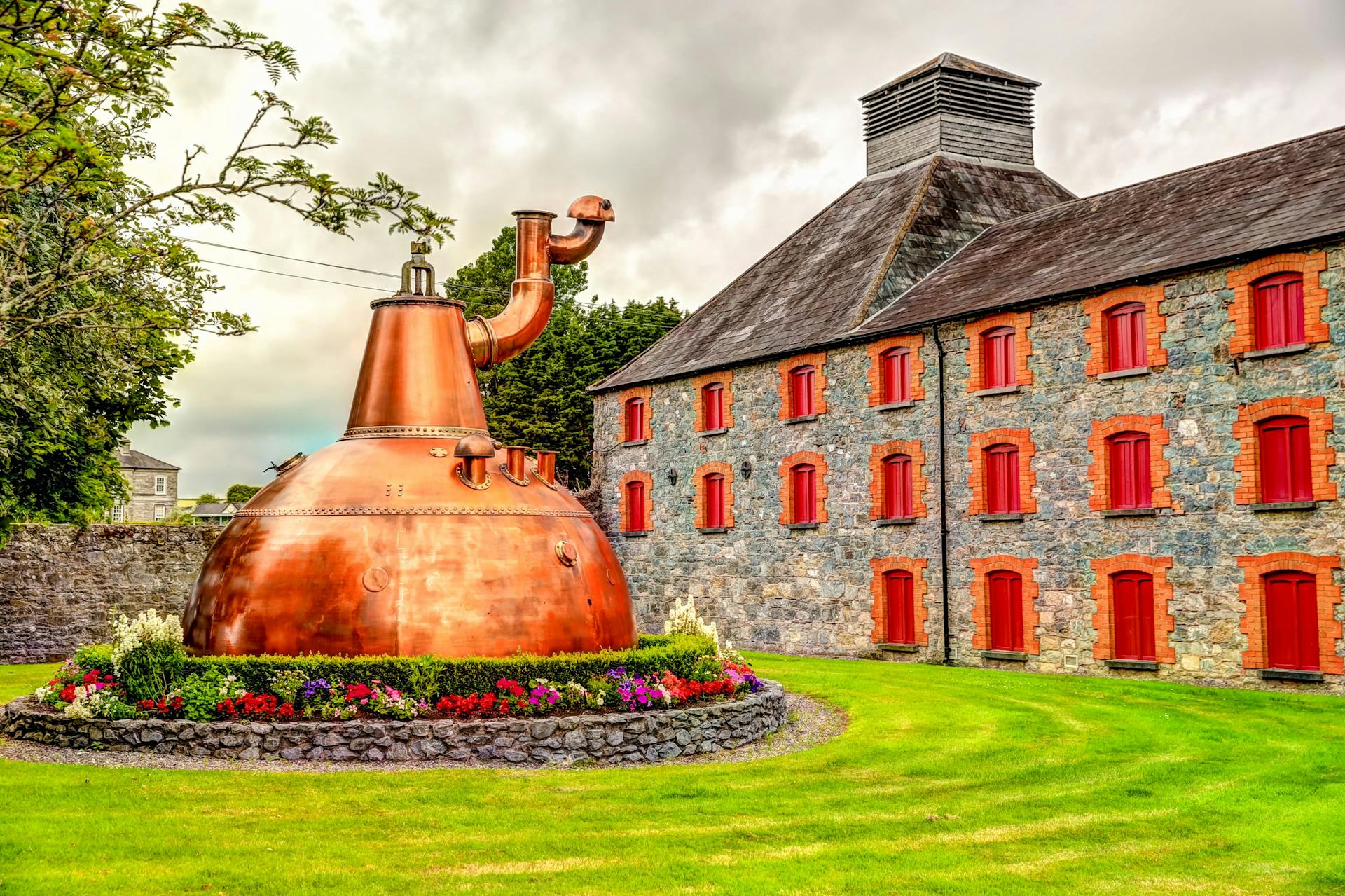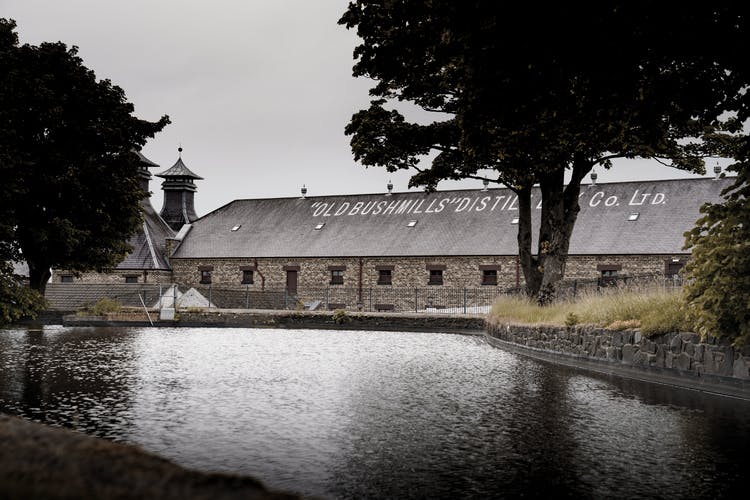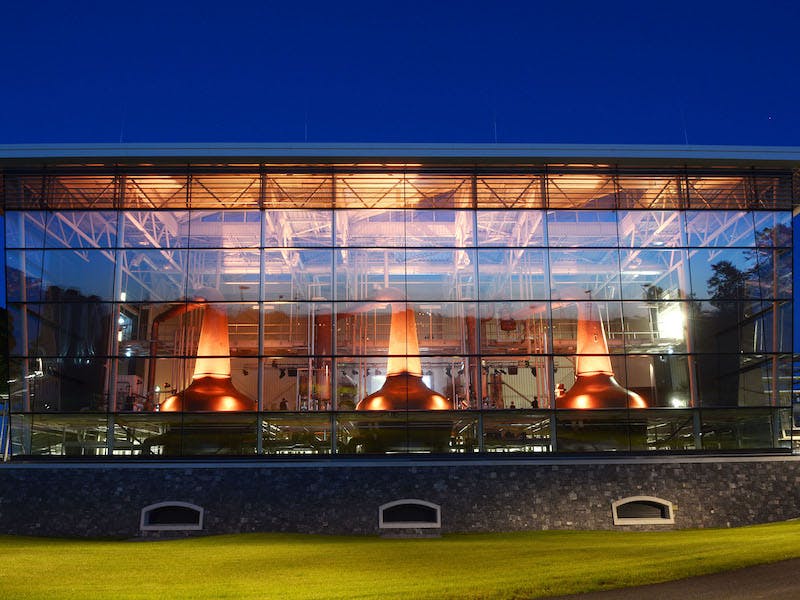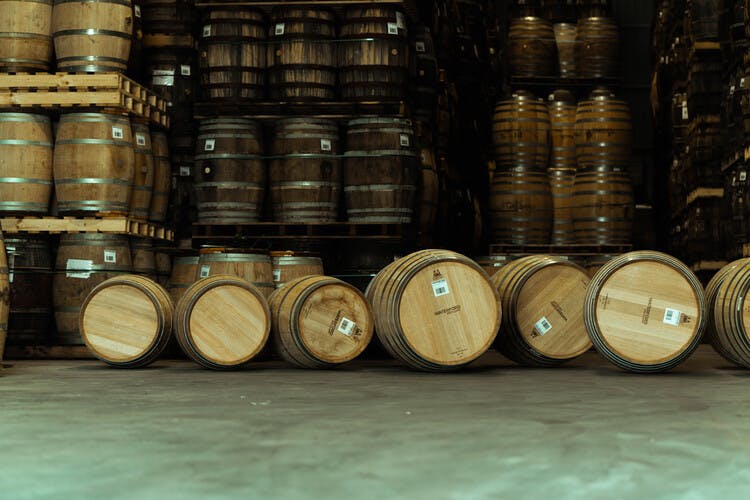
Whether the birthplace of whisky is attributed to Scotland or Ireland, this country is undoubtedly a historic and essential producer of whisky, which experienced its golden age in the 19th century, thanks to the Industrial Revolution.
And while, since the beginning of the 20th century, Scotch whisky has taken the lead over Irish whiskey, it is somewhat ironic, as it was through an Irish invention—the column still by Aeneas Coffey—that Scotland was able to significantly increase its production.
In this article, we will look back at the history of Irish whiskey, before exploring its unique characteristics and its leading distilleries.
At the origin of Irish whiskey
According to legend, the history of Irish whiskey dates back to 432, when Irish missionaries, led by Saint Patrick, brought back from their journeys in the Middle East the technique of distillation, which made it possible to produce uisge beatha, the Celtic term for "water of life."
However, it was not until the 15th century that records explicitly mention the production of a distilled drink made from grains such as barley, wheat, or oats.
Until then, it is commonly believed that uisge beatha, initially intended for medicinal purposes, resembled more of a herbal and honey-flavoured liqueur than whisky.

What is the difference between “whiskey” and “whisky”?
The use of the spelling “whiskey” with an "e" to refer to Irish whiskey dates back several centuries.
This distinction between Irish whiskey and Scotch whisky (or whisky from other countries) is not the result of any specific law or regulation but developed during the 19th century, a period when the whisky industry expanded significantly in both Scotland and Ireland.
At that time, Irish producers began using the spelling “whiskey” with an "e" to highlight the superior quality of their product compared to their Scottish competitors, at least from their perspective.
This practice was also adopted by American whiskey producers, largely influenced by Irish immigration, which helped popularise the “whiskey” spelling in the United States.
From glory to revival through the decline of Irish whiskey
A glorious past for Irish whiskey
At the beginning of the 19th century, Ireland counted around forty licensed distilleries, rising to 88 by the mid-19th century, with production exceeding 100 million litres of whisky.
In 1823, the British Parliament passed a law aimed at encouraging distilleries equipped with stills of more than 160 litres capacity, to counter the growing number of illicit distilleries.
Whisky production then became a fully-fledged industry, dominated by two Dublin-based companies: John Jameson & Son and John Power & Son.
These family-run businesses benefited from the advances of the Industrial Revolution, particularly improvements in maritime and railway transport, as well as innovations in communication methods, to expand their trade internationally.
Thanks to this strategy, Irish whiskey enjoyed great popularity within the British Empire and in the United States during the first half of the 19th century. With more than 160 licensed distilleries established across the country, the future of Irish whiskey looked promising.
Between 1823 and 1900, whisky production even quadrupled. Irish whiskey, with over 12 million cases sold and distributed across a hundred countries, was the most consumed spirit worldwide.
The decline of Irish whiskey
After more than a century of continuous growth, until the early 20th century, Irish whiskey faced a series of historical events that damaged its popularity and development.
In 1916, the Easter Rising against the British marked a turning point in Ireland's push for independence, at a time when the world was already at war.
Barley became a priority resource for the war effort, and distilleries halted production due to a shortage of raw materials.
Two years later, Prohibition in the United States further worsened the situation for Irish whiskey producers, as Ireland was then the main exporting country to America.

As a result, local substitutes were sold as Irish whiskey. This counterfeiting severely damaged the reputation of Irish whiskey, as even after Prohibition ended in 1933, consumers continued to turn away from it.
By 1930, eight years after Ireland's war of independence from England, tensions between the two countries remained high, notably through the imposition of various trade restrictions.
These tariffs once again led to the loss of one of Irish whiskey’s most important markets.
After the Second World War, Irish whiskey gave way to Scotch whisky in the hearts of European consumers.
By 1953, only six distilleries remained in Ireland, catering mainly to local demand.
Irish Distillers and the revival of Irish whiskey
In 1966, the distilleries Jameson, Powers, and Cork Distillers Company joined forces to create Irish Distillers Limited and acquired the remaining distilleries, such as Bushmills and Midleton.
In 1988, the Pernod Ricard group acquired Irish Distillers Limited, propelling Irish whiskey back into the spotlight. The group provided its new Irish subsidiary with significant resources to recover and reclaim the market.
At the same time, Cooley, the first independent distillery to open in the country in over a century, began operations. This opening inspired other distilleries such as Dingle in 2012 and Tullamore Dew in 2014.
Today, Irish whiskey production is experiencing an impressive revival. The Irish whiskey industry generates over €1.5 billion in exports and produced more than 130 million bottles in 2020.
What sets Irish whiskey apart from other whiskies
Ireland, the birthplace of triple distillation
As the birthplace of triple distillation, Ireland is known for its light and fruity style whiskeys. The country has the highest concentration of distilleries using this method, from Tullamore Dew to Midleton.
While some distilleries in Scotland and the United States also use triple distillation, it remains very rare.
Compared to double distillation, triple distillation lengthens the production schedule and increases costs, but it results in refined distillates that have come to define the Irish style.
Single Pot Still: an Irish tradition
Originally made from a blend of grains and distilled in a pot still, single pot still is the most traditional of Irish whiskeys.
A single pot still whiskey is produced from malted and unmalted barley, sometimes supplemented by a third grain (such as oats, wheat, or rye). The proportion of malted and unmalted barley, which varies, generally hovers around 40% to 50%. This tradition originated from a tax introduced in 1785 on malted barley, which encouraged distillers to use unmalted grains to avoid it.
For example, Midleton continues to uphold this tradition, while Bushmills opted for the production of single malts at the end of the 19th century.
3 flagship distilleries of Irish whiskey
In the North: Bushmills
Located near the River Bush in County Antrim, Bushmills is the name of a small village in Northern Ireland. The distillery of the same name is one of the very first in the world to have obtained a licence, in 1784 (although the region had been granted distilling rights as early as 1608).

It is the oldest Irish whiskey distillery still in operation.
As early as 1890, it actively took part in exporting its Irish whiskey worldwide, thanks to its ship, the “S.S. Bushmills,” which made an inaugural voyage to the United States, then to China, and finally to Japan.
In 1972, Bushmills was acquired by Irish Distillers Limited. At that time, only two production sites remained in operation: Bushmills in the North and Midleton in the South.
Today, Bushmills ranks third among the best-selling Irish whiskeys worldwide, behind Jameson and Tullamore D.E.W., but holds second place in production capacity, with 4.5 million litres of alcohol per year. Only the Midleton distillery surpasses it in capacity.
The distillery produces single malts that perfectly embody the exuberant, fruity Irish style, developing notes of tropical fruits like pineapple and mango as they age. Bushmills also produces blends, combining its single malts with grain whiskeys from another distillery.
In the South: Midleton
Midleton is one of the most technologically advanced distilleries in the world. Located in County Cork, in the south of Ireland, the distillery has played a crucial role in the rise of Irish whiskey globally.
Founded in 1825 by the Murphy brothers, the Midleton distillery quickly gained recognition, particularly thanks to the entrepreneurial talents of the two brothers. The distillery greatly contributed to the structuring of the Irish Distillers group, which made it its main production site in 1975.

The distillery quickly became a cornerstone of Irish whiskey, with a production capacity of over 50 million litres of pure alcohol per year.
Midleton is not just a production powerhouse but also a laboratory for Irish whiskey. More than 15 expressions are produced at this distillery, including Redbreast, Jameson, Power’s, and Midleton whiskey itself.
Today, the distillery is also a leisure destination, as the old distillery is open to the public, offering visitors the chance to explore the vast site and see its stills (now silent), one of which could produce up to 144,000 litres of pure alcohol per year.
Midleton produces both Single Pot Still whiskeys, triple distilled in pot stills, and grain whiskeys in large column stills, which form the base of light and fruity blends like Jameson or Power’s.
Richer and oilier thanks to the inclusion of unmalted barley, single pot still whiskeys—like Redbreast, for example—often display greater complexity, partly due to partial ageing in sherry casks.
In the East: Waterford
Waterford is a relatively new distillery in the whisky world, but it has quickly gained recognition thanks to its unique and innovative approach to whisky production.
Founded in 2015 by Mark Reynier, previously involved in the revival of the Bruichladdich distillery on the Isle of Islay in Scotland, Waterford was established with the ambition of producing exceptional whiskies by focusing on terroir.
The distillery was commissioned in 2015 with the goal of creating the finest single malt whisky by harnessing the diversity of Irish soils.

To achieve this, the Irish distillery sourced barley from over 70 Irish farms, each offering unique characteristics thanks to their specific terroir, ranging from different soil types to varied microclimates.
The distillery has adopted a scientific approach to trace and analyse the influence of terroir on the whisky: each batch of barley is fermented, distilled, and aged separately, allowing the distillery to create a library of spirits expressing a wide range of flavour profiles.
The launch of its first bottles in 2020 was very well received, sparking interest within the whisky community in the importance of terroir.
Produced from prolonged fermentation, carefully distilled, and matured in a variety of oak casks selected for their excellence and unique characteristics, each limited edition reflects a Single Farm origin.
TO EXPLORE WHISKIES FURTHER
La Maison du Whisky has three boutiques in Paris:
In each of these boutiques, you'll find a wide selection of whiskies, rums, sakes, and other fine spirits.
Because a whisky can be described in a thousand words, our experts will be delighted to guide you through the must-try Irish whiskeys at La Maison du Whisky.
Follow our tasting calendar for upcoming events, or visit the Golden Promise Whisky Bar, which offers an extensive selection of whiskies and other spirits by the glass.